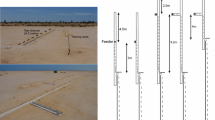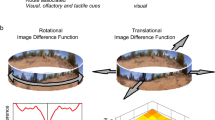Abstract
Ants are expert navigators, keeping track of the vector to home as they travel, through path integration, and using terrestrial panoramas in view-based navigation. Although insect learning has been much studied, the learning processes in navigation have not received much attention. Here, we investigate in desert ants (Melophorus bagoti) the effects of repeating a well-travelled and familiar route segment without success. We find that re-running a homeward route without entering the nest impacted subsequent trips. Over trips, ants showed more meandering from side to side and more scanning behaviour, in which the ant stopped and turned, rotating to a range of directions. In repeatedly re-running their familiar route, ants eventually gave up heading in the nestward direction as defined by visual cues and turned to walk in the opposite direction. Further manipulations showed that the extent and rate of this path degradation depend on (1) the length of the vector accumulated in the direction opposite to the food-to-nest direction, (2) the specific visual experience of the repeated segment of the route that the ants were forced to re-run, and (3) the visual panorama: paths are more degraded in an open panorama, compared with a visually cluttered scene. The results show that ants dynamically modulate the weighting given to route memories, and that fits well with the recent models, suggesting that the mushroom bodies provide a substrate for the reinforcement learning of views for navigation.



Similar content being viewed by others
Data acessibility
The raw data files and a file containing explanations are in the supplementary materials.
References
Andel D, Wehner R (2004) Path integration in desert ants, Cataglyphis fortis: how to make a homing ant run away from home. Proc R Soc B Biol Sci 271:1485–1489
Ardin P, Peng F, Mangan M, Lagogiannis K, Webb B (2016) Using an insect mushroom body circuit to encode route memory in complex natural environments. PLoS Computat Biol 12:e1004683
Aso Y, Sitaraman D, Ichinose T, Kaun KR, Vogt K, Belliart-Guérin G, Plaçais P-Y, Robie AA, Yamagata N, Schnaitmann C, Rowell WJ, Johnston RM, Ngo T-TB, Chen N, Korff W, Nitabach MN, Heberlein U, Preat T, Branson KM, Tanimoto H, Rubin GM (2014) Mushroom body output neurons encode valence and guide memory-based action selection in Drosophila. eLife 3:e04580
Bazhenov M, Huerta R, Smith BH (2013) A computational framework for understanding decision making through integration of basic learning rules. J Neurosci 33:5686–5697
Cheng K (2012) How to navigate without maps: the power of taxon-like navigation in ants. Comp Cogn Behav Rev 7:1–22
Cheng K, Narendra A, Sommer S, Wehner R (2009) Traveling in clutter: Navigation in the Central Australian desert ant Melophorus bagoti. Behav Process 80:261–268
Cheng K, Schultheiss P, Schwarz S, Wystrach A, Wehner R (2014) Beginnings of a synthetic approach to desert ant navigation. Behav Process 102:51–61
Christian KA, Morton SR (1992) Extreme thermophilia in a Central Australian ant, Melophorus bagoti. Physiol Zool 65:885–905
Cohn R, Morantte I, Ruta V (2015) Coordinated and compartmentalized neuromodulation shapes sensory processing in Drosophila. Cell 163:1742–1755
Collett M (2012) How navigational guidance systems are combined in a desert ant. Curr Biol 22:927–932
Collett M (2014) A desert ant’s memory of recent visual experience and the control of route guidance. Proc R Soc B Biol Sci 281:20140634
Collett TS, Collett M (2000) Path integration in insects. Curr Opinion Neurobiol 10:757–762
Collett TS, Graham P, Harris RA (2007) Novel landmark-guided routes in ants. J Exp Biol 210:2025–2032
Collett M, Chittka L, Collett TS (2013) Spatial memory in insect navigation. Curr Biol 23:R789–R800
Cruse H, Wehner R (2011) No need for a cognitive map: Decentralized memory for insect navigation. PLoS Computat Biol 7:e1002009
Freas CA, Cheng K (2017) Learning and time-dependent cue choice in the desert ant, Melophorus bagoti. Ethol 123:503–515
Freas CA, Fleischmann PN, Cheng K (2019) Experimental ethology of learning in desert ants: becoming expert navigators. Behav Process 158:181–191
Galizia CG (2014) Olfactory coding in the insect brain: data and conjectures. Eur J Neurosci 39:1784–1795
Graham P, Cheng K (2009) Ants use the panoramic skyline as a visual cue during navigation. Curr Biol 19:R935–R937
Graham P, Mangan M (2015) Insect navigation: do ants live in the now? J Exp Biol 218:819–823
Hoinville T, Wehner R (2018) Optimal multiguidance integration in insect navigation. Proc Natl Acad Sci USA 115:2824–2829
Huber R, Knaden M (2017) Homing ants get confused when nest cues are also route cues. Curr Biol 27:3706–3710.e1–e2
Knaden M, Graham P (2016) The sensory ecology of ant navigation: from natural environments to neural mechanisms. Annu Rev Entomol 61:63–76
Kodzhabashev A, Mangan M (2015) Route following without scanning. In: Wilson SP, Verschure PMFJ, Mura A, Prescott TJ (eds) Conference on Biomimetic and Biohybrid Systems. Springer, pp 199–210
Kohler M, Wehner R (2005) Idiosyncratic route memories in desert ants, Melophorus bagoti: How do they interact with path integration vectors? Neurobiol Learn Mem 83:1–12
Legge ELG, Wystrach A, Spetch ML, Cheng K (2014) Combining sky and earth: desert ants (Melophorus bagoti) show weighted integration of celestial and terrestrial cues. J Exp Biol 217:4159–4166
Lent D, Graham P, Collett TS (2010) Image-matching during ant navigation occurs through saccade-like body turns controlled by learnt visual features. Proc Natl Acad Sci USA 107:16348–16353
Merkle T, Wehner R (2010) Desert ants use foraging distance to adapt the nest search to the uncertainty of the path integrator. Behav Ecol 21:349–355
Merkle T, Knaden M, Wehner R (2006) Uncertainty about nest position influences systematic search strategies in desert ants. J Exp Biol 209:3545–3549
Müller M, Wehner R (1988) Path integration in desert ants, Cataglyphis fortis. Proc Natl Acad Sci USA 85:5287–5290
Muser B, Sommer S, Wolf H, Wehner R (2005) Foraging ecology of the thermophilic Australian desert ant, Melophorus bagoti. Aust J Zool 53:301–311
Narendra A (2007) Homing strategies of the Australian desert ant Melophorus bagoti II. Interaction of the path integrator with visual cue information. J Exp Biol 210:1804–1812
Peng F, Chittka L (2017) A simple computational model of the bee mushroom body can explain seemingly complex forms of olfactory learning and memory. Curr Biol 27:224–230
Perry CJ, Barron AB, Cheng K (2013) Invertebrate learning and cognition: relating phenomena to neural substrate. Wiley Interdiscip Rev Cogn Sci. https://doi.org/10.1002/wcs.1248
Pritchard DJ, Healy SD (2017) Homing and navigation. In: Call J (ed) APA handbook of comparative psychology. American Psychological Association, Washington, DC, pp 485–508
Ronacher B (2008) Path integration as the basic navigation mechanism of the desert ant Cataglyphis fortis (Forel, 1902) (Hymenoptera: Formicidae). Myrmecol News 11:53–62
Schultheiss P, Wystrach A, Legge ELG, Cheng K (2013) Information content of visual scenes influences systematic search of desert ants. J Exp Biol 216:742–749
Schultheiss P, Cheng K, Reynolds AM (2015) Searching behavior in social Hymenoptera. Learn Motiv 50:59–67
Stone T, Webb B, Adden A, Weddig NB, Honkanen A, Templin R, Wcislo W, Scimeca L, Warrant E, Heinze S (2017) An anatomically constrained model for path integration in the bee brain. Curr Biol 27:3069–3085.e1–e11
Webb B, Wystrach A (2016) Neural mechanisms of insect navigation. Curr Opin Insect Sci 15:27–39
Wehner R (2003) Desert ant navigation: how miniature brains solve complex tasks. J Comp Physiol A 189:579–588
Wehner R, Srinivasan MV (1981) Searching behaviour of desert ants, genus Cataglyphis (Formicidae, Hymenoptera). J Comp Physiol A 142:315–338
Wehner R, Srinivasan MV (2003) Path integration in insects. In: Jeffery KJ (ed) The neurobiology of spatial behaviour. Oxford University Press, Oxford, pp 9–30
Wehner R, Hoinville T, Cruse H, Cheng K (2016) Steering intermediate courses: desert ants combine information from various navigational routines. J Comp Physiol A 202:459–472
Wystrach A, Beugnon G, Cheng K (2011a) Landmarks or panoramas: what do navigating ants attend to for guidance? Front Zool 8:21
Wystrach A, Schwarz S, Schultheiss P, Beugnon G, Cheng K (2011b) Views, landmarks, and routes: how do desert ants negotiate an obstacle course? J Comp Physiol A 197:167–179
Wystrach A, Philippides A, Aurejac A, Cheng K, Graham P (2014) Visual scanning behaviours and their role in the navigation of the Australian desert ant Melophorus bagoti. J Comp Physiol A 200:615–626
Wystrach A, Mangan M, Webb B (2015) Optimal cue integration in ants. Proc R Soc B Biol Sci 282:20151484
Zeil J, Hofmann MI, Chahl JS (2003) Catchment areas of panoramic snapshots in outdoor scenes. J Opt Soc Am 20:450–469
Zeil J, Narendra A, Stürzl W (2014) Looking and homing: how displaced ants decide where to go. Phil Trans R Soc B 369:20130034
Acknowledgements
We thank the Centre for Appropriate Technology at Alice Springs, Australia for letting us work on their property and providing some storage space, and the CSIRO Arid Zone Research at Alice Springs for administrative support.
Funding
The research was funded by a grant from the Australian Research Council to KC (DP110100608), by BBSRC funding to PG, and by a Fyssen Foundation fellowship to AW. PG is additionally funded by the EPSRC (EP/P006094/1).
Author information
Authors and Affiliations
Contributions
AW, SS, and PG conceived and designed the study. AW and SS carried out experimentation and digitised the paths. AW analysed the data. AW drew the figures. PG and KC drafted the manuscript. All authors revised the manuscript and agreed on the final version of it.
Corresponding author
Ethics declarations
Conflict of interests
The authors declare that they have no competing interests.
Ethics standards
Australia has no ethical regulations regarding work with insects. The experimentation carried out was, moreover, non-invasive, and no long-term aversive effects on the nests or on the tested individuals were observed.
Additional information
Publisher’s Note
Springer Nature remains neutral with regard to jurisdictional claims in published maps and institutional affiliations.
Electronic supplementary material
Below is the link to the electronic supplementary material.
Rights and permissions
About this article
Cite this article
Wystrach, A., Schwarz, S., Graham, P. et al. Running paths to nowhere: repetition of routes shows how navigating ants modulate online the weights accorded to cues. Anim Cogn 22, 213–222 (2019). https://doi.org/10.1007/s10071-019-01236-7
Received:
Revised:
Accepted:
Published:
Issue Date:
DOI: https://doi.org/10.1007/s10071-019-01236-7




